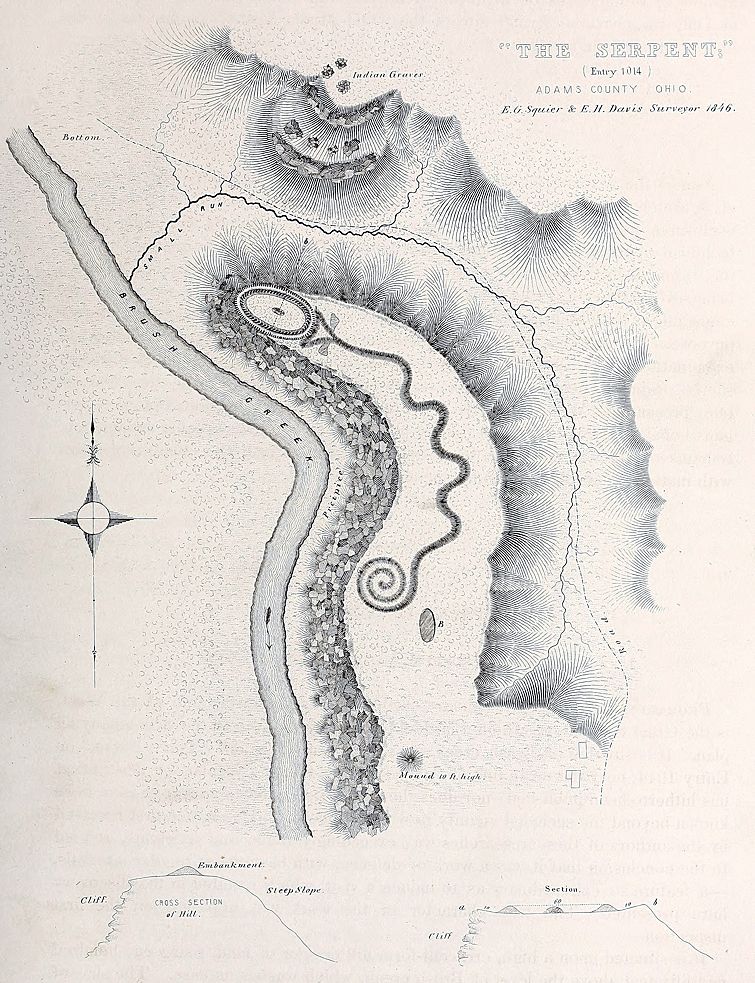PLATE XXXV
THE GREAT SERPENT, ADAMS COUNTY, OHIO.
Probably the most extraordinary earthwork thus far discovered at the West, is the Great Serpent, of which a faithful delineation is given in the accompanying plan. It is situated on Brush creek, at a point known as the "Three Forks," on Entry 1014, near the north line of Adamscounty, Ohio. No plan or description has hitherto been published; nor does the fact of its existence appear to have been known beyond the secluded vicinity in which it occurs. The notice first received by the authors of these researches was exceedingly vague and indefinite, and led
to the conclusion that it was a work of defence, with bastions at regular intervals, --a feature so extraordinary as to induce a visit, which resulted in the discovery here presented. The true character of the work was apparent on the first inspection.
It is situated upon a high, crescent-form hill or spur of land, rising one hundred and fifty feet above the level of Brush creek, which washes its base. The side of the hill next the stream presents a perpendicular wall of rock, while the other slopes rapidly, though it is not so steep as to preclude cultivation. The top of the hill is not level but slightly convex, and presents a very even surface, one hundred and fifty feet wide by one thousand long, measuring from its extremity to the point where it connects with the table land. Conforming to the curve of the hill, and occupying its very summit, is the serpent, its head resting near the point, and its body winding back for seven hundred feet, in graceful undulations, terminating in a triple coil at the tail. The entire length, if extended, would be not less than one thousand feet. The accompanying plan, laid down from accurate survey, can alone give an adequate conception of the outline of the work, which is clearly and boldly defined, the embankment being upwards of five feet in height by thirty feet base, at the centre of the body, but diminishing somewhat towards the head and tail. The neck of the serpent is stretched out and slightly curved, and its mouth is opened wide as if in the act of swallowing or ejecting an oval figure, which rests partially within the distended jaws. This oval is formed by an embankment of earth, without any perceptible opening, four feet in height, and is perfectly regular in outline, its transverse and conjugate diameters being one hundred and sixty and eighty feet respectively. The ground within the oval is slightly elevated: a small circular elevation of large stones much burned once existed in its centre; but they have been thrown down and scattered by some ignorant visitor, under the prevailing impression probably that gold was hidden beneath them. The point of the hill, within which this egg-shaped figure rests, seems to have been artificially cut to conform to its outline, leaving a smooth platform, ten feet wide, and somewhat inclining inwards, all around it. The section a b will illustrate this feature.
Upon either side of the serpent's head extend two small triangular elevations, ten or twelve feet over. They are not high, and although too distinct to be overlooked, are yet too much obliterated to be satisfactorily traced. Besides a platform, or level oval terrace, at B, and a large mound in the centre of the isthmus connecting the hill with the table land beyond, there are no other remains, excepting a few mounds, within six or eight miles, --none, perhaps, nearer than the entrenched hill in Highland county, thirteen miles distant. There are a number of works lower down on Brush creek, towards its mouth; but their character is not known. The point on which this effigy occurs commands an extensive prospect, overlooking the "bottoms" found at the junction of the three
principal tributaries of the creek. The alluvial terraces are here quite extensive, and it is a matter of surprise that no works occur upon them.
The serpent, separate or in combination with the circle, egg, or globe, has been a predominant symbol among many primitive nations. It prevailed in Egypt, Greece, and Assyria, and entered widely into the superstitions of the Celts, the Hindoos, and the Chinese. It even penetrated into America; and was conspicuous in the mythology of the ancient Mexicans, among whom its significance does not seem to have differed materially from that which it possessed in the old world. The fact that the ancient Celts, and perhaps other nations of the old continent, erected
sacred structures in the form of the serpent, is one of high interest. Of this description was the great temple of Abury, in England, --in many respects the most imposing ancient, monument of the British islands.
Ephraim George Squier and Edwin Hamilton Davis, Ancient Monuments of the Mississippi Valley: Comprising the Results of Extensive Original Surveys and Explorations (1848).
| |

| |
2015.10.02 18:36
Rowan Moore on Zaha Hadid
I thought Moore was going to tell us how and why Hadid and her office chose to "set about creating ever more elaborate and disconnected icons." In fact, after presenting a continual string of anecdotes, it's not at all clear that Hadid and her office even made such a choice. I think Moore is guilty of some false reporting here.
|